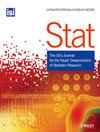迪里夏特分布的渐近有效闭式估计器
IF 0.8
4区 数学
Q3 STATISTICS & PROBABILITY
引用次数: 0
摘要
狄利克雷分布的极大似然估计量通常是用Newton-Raphson算法求得的。然而,在某些情况下,计算成本可能是繁重的,例如,在实时进程中。因此,对于大样本,开发一种与最大似然估计一样有效的封闭估计是有益的。本文在经典大样本理论的基础上,提出了渐近有效闭型估计量。本文章由计算机程序翻译,如有差异,请以英文原文为准。
An asymptotically efficient closed-form estimator for the Dirichlet distribution
Maximum likelihood estimator (MLE) of the Dirichlet distribution is usually obtained by using the Newton–Raphson algorithm. However, in some cases, the computational costs can be burdensome, for example, in real-time processes. Therefore, it is beneficial to develop a closed-form estimator that is as efficient as the MLE for large sample. Here, we suggest asymptotically efficient closed-form estimator based on the classical large sample theory.
求助全文
通过发布文献求助,成功后即可免费获取论文全文。
去求助
来源期刊

Stat
Decision Sciences-Statistics, Probability and Uncertainty
CiteScore
1.10
自引率
0.00%
发文量
85
期刊介绍:
Stat is an innovative electronic journal for the rapid publication of novel and topical research results, publishing compact articles of the highest quality in all areas of statistical endeavour. Its purpose is to provide a means of rapid sharing of important new theoretical, methodological and applied research. Stat is a joint venture between the International Statistical Institute and Wiley-Blackwell.
Stat is characterised by:
• Speed - a high-quality review process that aims to reach a decision within 20 days of submission.
• Concision - a maximum article length of 10 pages of text, not including references.
• Supporting materials - inclusion of electronic supporting materials including graphs, video, software, data and images.
• Scope - addresses all areas of statistics and interdisciplinary areas.
Stat is a scientific journal for the international community of statisticians and researchers and practitioners in allied quantitative disciplines.
 求助内容:
求助内容: 应助结果提醒方式:
应助结果提醒方式:


